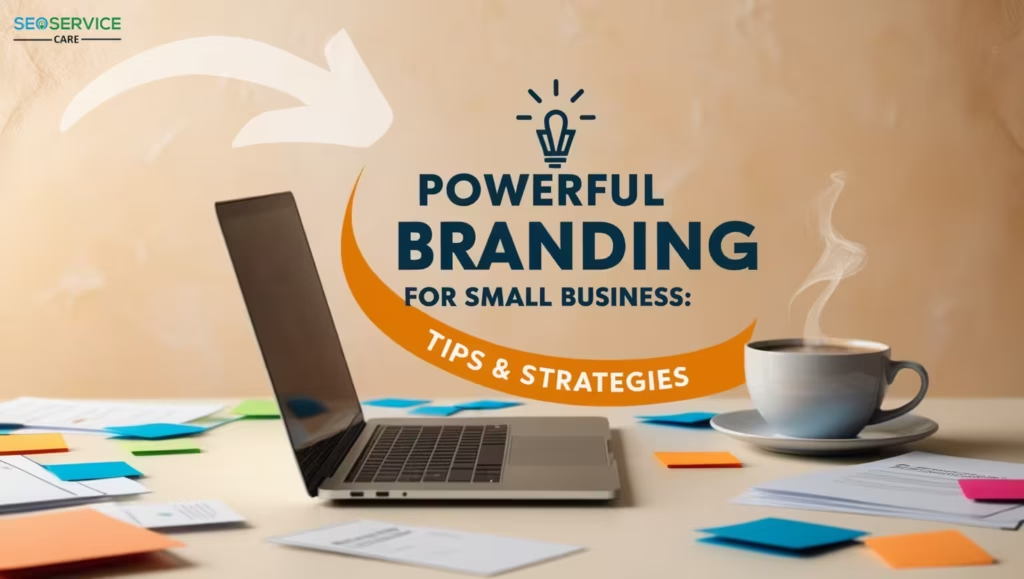Imagine this: you walk into a store and feel an immediate connection. It’s not just about the products; it’s how the store presents itself—the colors, the vibe, the way the staff interacts. This is branding for small business in action. For small businesses, effective branding is vital for creating recognition, building trust, and fostering customer loyalty. But what exactly does branding entail, and how can you do it effectively?
What is Branding and Why is it Important for Small Businesses?
Definition of Branding: Branding is the process of creating a unique identity for your business. This includes your name, logo, design, and overall message. It’s how customers perceive your business and differentiate it from competitors.
Example: Think about a local coffee shop that you frequent. It’s not just the coffee that draws you in; it’s the cozy atmosphere, friendly baristas, and welcoming vibe that make it your favorite spot. This is branding at work—creating a feeling and experience that customers connect with.
Importance of Branding for a Small Business:
- Memorability: Consistent branding helps customers remember your business.
- Trust and Credibility: A professional, consistent brand creates trust, which is essential for small businesses looking to build a loyal customer base.
- Competitive Edge: In a crowded market, a well-crafted brand helps you stand out.
Expert Insight: According to branding expert Marty Neumeier, “A brand is not what you say it is—it’s what they say it is.” This highlights the importance of aligning your branding with customer perception.
How to Create a Strong Small Business Brand
Crafting a robust brand involves careful planning and consistency. Here’s a step-by-step breakdown:
a) Define Your Core Values and Mission
- Determine Your Values: Think about what your business stands for. Are you focused on sustainability, innovation, customer service, or affordability?
- Craft a Mission Statement: This statement should encapsulate your business’s purpose and direction in one or two sentences.
Example: A small eco-friendly skincare brand might have a mission statement like, “To provide high-quality, sustainable skincare solutions that are kind to both people and the planet.”
b) Understand Your Target Audience
- Research Your Ideal Customer: Identify their age, preferences, values, and pain points.
- Create Buyer Personas: Develop detailed personas to understand how best to communicate with your audience.
Tip: Use surveys, social media polls, and customer feedback to gather insights into your target market.
Develop Your Brand Voice and Personality
Your brand’s voice is the way you communicate with your audience. It should be consistent across all platforms, from your website to social media and customer service interactions.
Steps to Find Your Brand Voice:
- Identify Your Core Characteristics: Are you friendly, authoritative, playful, or serious?
- Align with Your Audience’s Expectations: If your target market is young adults, a casual and humorous tone might be appropriate. For a legal consultancy, a professional and straightforward tone would work better.
- Create a Style Guide: Document your tone, common phrases, and style rules to ensure consistency.
Real-World Example: The clothing brand Patagonia is known for its adventurous and eco-conscious voice, which aligns with its outdoor-loving audience.
Visual Branding: Build a Recognizable Look
A strong visual identity makes your brand memorable. This includes your logo, color scheme, fonts, and imagery.
a) Designing a Logo
- Keep it Simple: Simple logos are easier to remember and reproduce.
- Ensure Scalability: Make sure your logo looks good on everything from business cards to billboards.
b) Choosing a Color Scheme
- Use Color Psychology: Colors evoke emotions. For example, blue conveys trust, while red signifies energy and excitement.
- Be Consistent: Use the same colors across all branding materials for a cohesive look.
Example: Coca-Cola’s consistent use of red and white reinforces its image of excitement and energy.
c) Selecting Fonts
- Match Your Brand Personality: A formal font like ‘Times New Roman’ might suit a law firm, while a playful script could fit a bakery.
- Ensure Readability: Choose fonts that are easy to read across all devices and print materials.
Share Your Story: Connect Through Personal Narratives
People are naturally drawn to stories. Sharing your business’s journey creates an emotional connection with your audience.
How to Craft Your Brand Story:
- Start with Your ‘Why’: Why did you start your business? What challenges did you overcome?
- Keep it Authentic: Customers can tell when a story is genuine or exaggerated.
- Integrate Your Values: Ensure that your story reflects the values you defined earlier.
Example: A family-run café might share how recipes have been passed down for generations, creating a sense of heritage and warmth.
Build Trust Through Consistency
Consistency is key to reinforcing your brand’s identity. Customers should recognize your brand immediately, whether they see it on social media, your website, or in person.
Tips for Maintaining Consistency:
- Use a Style Guide: Ensure your team knows the colors, fonts, and tone to use in all communications.
- Maintain Visual Elements: Logos, taglines, and brand colors should be uniform across all channels.
Why Consistency Matters: Studies have shown that consistent presentation of a brand can increase revenue by up to 23%.
Budget-Friendly Branding Ideas for Small Businesses
Creating a strong brand doesn’t require a huge budget. Here are some cost-effective tips:
a) Use Free Design Tools
- Tools like Canva: Perfect for creating social media posts, flyers, and logos.
- DIY Logo Makers: Platforms like Looka and Tailor Brands can help with logo creation.
b) Social Media Engagement
- Utilize Free Platforms: Instagram, Facebook, and TikTok are great for showcasing your brand’s personality.
- Interact with Followers: Respond to comments and share user-generated content to build community.
c) Highlight Customer Testimonials
- Ask for Reviews: Encourage happy customers to leave reviews on your website and platforms like Google My Business.
- Feature Reviews: Share testimonials on your website and social media to build credibility.
The Role of Customer Experience in Branding
Definition: Customer experience encompasses every interaction a customer has with your brand.
Why It’s Part of Branding:
- Consistent Experience: Whether a customer is calling for support or visiting your store, they should receive the same level of service.
- Memorable Interactions: Make each customer interaction positive and reflective of your brand’s values.
Actionable Tip: Train your staff to embody your brand values, ensuring consistency in how customers are treated.
Strategies for Building Brand Loyalty
Loyal customers are the backbone of any business. Here’s how to foster brand loyalty:
a) Offer Exceptional Service
- Go the Extra Mile: Personalize customer service with names and preferences.
- Solve Problems Quickly: Responsive customer service builds trust.
b) Implement a Loyalty Program
- Reward Repeat Customers: Points systems and discounts encourage repeat business.
c) Use Personalization
- Tailored Marketing: Send personalized emails or targeted promotions based on customer data.
Stay Adaptable Without Losing Your Core Identity
Your brand needs to grow and evolve as your business expands. However, it’s crucial to stay true to your brand’s core values.
Tips for Evolution:
- Refresh Branding Strategically: Update logos or color schemes subtly over time to stay modern.
- Communicate Changes: Keep your audience informed about any major changes to avoid confusion.
Collaborate with Other Brands
Partnering with other brands can help you reach new audiences.
Tips for Collaboration:
- Find a Complementary Partner: Choose a business that adjusts to your values.
- Host Joint Events: Consider co-branded events or social media takeovers.
Use Data to Measure Branding Success
To know if your branding strategy is working, measure and analyze key metrics.
Metrics to Track:
- Customer Feedback: Monitor reviews and direct feedback for insights.
- Social Media Engagement: Track likes, shares, and comments.
- Repeat Business: Measure customer return rates.
Common Branding Mistakes to Avoid
Avoid these pitfalls to keep your branding effective:
- Inconsistency: Ensure your brand elements are consistent across all platforms.
- Ignoring Audience Needs: Your branding should always align with customer expectations.
- Overcomplicating Your Message: Keep it simple and clear for better recall.
Emotional Branding: Building Deeper Connections
Creating emotional ties with your customers can transform them into loyal advocates.
How to Use Emotional Branding:
- Support Causes: Associate your brand with meaningful causes that align with your values.
- Storytelling: Highlight stories that evoke emotions, such as customer success stories.
Example: Brands like TOMS Shoes have built loyalty by aligning their products with charitable giving.
Benefits of Effective Branding for Small Businesses
Investing in branding is investing in the future stability and expansion of the business. Effective branding brings many benefits to small businesses. Here’s how it can help:
1. Recognition and Differentiation
- Stand Out: A strong brand helps your business get noticed. A unique logo and name make it easier for customers to remember you.
- Be Different: Good branding shows what makes your business special compared to others.
2. Build Trust and Loyalty
- Trust: When your brand is consistent, people trust it more. They’ll feel safe buying from you.
- Loyal Customers: Good branding makes people feel connected to your business, so they come back again and again.
3. Increased Value
- Charge More: A strong brand can make your product or service seem more valuable. People may pay more if they trust your brand.
- Business Worth: Over time, a well-known brand can make your business more valuable.
4. Better Marketing
- Clear Message: With a strong brand, all your ads and social media posts send the same message. This helps people understand what you’re about.
- Reach the Right People: Branding helps you focus on the right customers, making your marketing more effective.
5. Happy Employees
- Pride: Employees like working for a business that has a good name. This makes them feel proud of their job.
- Attract Talent: A strong brand helps you attract good workers who want to be part of your business.
6. Stay Ahead of Competition
- Be the Leader: A strong brand helps your business stand out as a leader in your industry.
- Customer Recommendations: People who like your brand will tell others about it, helping you get more customers.
7. Growth and Opportunities
- Easier Growth: A strong brand makes it easier to expand your business, by adding new products or services.
- New Partnerships: Other businesses are more likely to work with you if your brand is known and trusted.
8. Survive Tough Times
- Keep Customers: During hard times, a strong brand helps keep customers coming back.
- Adapt Easily: If your business needs to change, a strong brand can help your customers stay loyal.
Common Mistakes to Avoid When Branding a Small Business
There are some common mistakes you should avoid. Here are a few to watch out for:
1. No Clear Brand Identity
- Mistake: Not knowing what your business stands for.
- Fix: Understand what makes your business different and make sure it shows in everything you do, like your logo and message.
2. Inconsistent Branding
- Mistake: Using different logos, colors, or messages in different places.
- Fix: Keep your design and message the same everywhere, like on your website, social media, and ads.
3. Not Knowing Your Audience
- Mistake: Not understanding what your customers need or want.
- Fix: Learn about your customers and make sure your brand speaks to them.
4. Too Complicated Message
- Mistake: Trying to say too much at once.
- Fix: Keep your message simple and clear. Focus on one thing you want customers to remember about your business.
5. Ignoring the Customer Experience
- Mistake: Focusing only on your logo and design but not thinking about how your customers feel when they use your service or product.
- Fix: Make sure the whole experience, like your website and customer service, matches your brand.
6. Not Being Authentic
- Mistake: Trying to copy other businesses instead of showing what makes your business unique.
- Fix: Be yourself! Share your story and show your true personality through your brand.
7. Bad Design
- Mistake: Using poor-quality images or a messy logo.
- Fix: Use high-quality designs for your logo, website, and marketing materials. And these make your brand look professional.
8. Not Focusing on the Internet
- Mistake: Not having a strong online presence.
- Fix: Make sure your business is easy to find online. To reach more people, Keep your website updated and be active on social media
9. Not Updating Over Time
- Mistake: Sticking with the same branding even when trends or customer needs change.
- Fix: Refresh your branding every now and then to keep it fresh and relevant.
10. Ignoring Feedback
- Mistake: Not listening to your customers’ opinions about your brand.
- Fix: Ask for feedback and be willing to make changes. It helps you improve your brand.
11. Not Keeping Customers Coming Back
- Mistake: Focusing only on getting new customers and forgetting about the ones you already have.
- Fix: Make your current customers feel special and encourage them to return.
12. Not Watching Online Reviews
- Mistake: Not paying attention to online reviews or comments about your brand.
- Fix: Pay attention to reviews and respond to them. Show customers you care about what they think.
Branding isn’t just about having a nice logo. It’s about making sure people understand what your business stands for. Avoiding these mistakes will help your business grow and succeed.
Final Thoughts: Start Your Branding Journey Today
Branding is more than just a logo. It’s how people perceive your business and how they feel about it. It’s a strong brand that helps people remember you, trust you, and come back again. Knowing what your business is all about, staying true to your values, and making sure every part of your business looks and feels the same are the ways you can build a brand that people will love.
You don’t need a big budget to start. With the right concepts, you could build a brand that would bring attention to your business. Keep your customers happy; stay true to your story, and your brand will grow into a successful one.
Ready to transform your small business into a memorable brand? Contact us today for tailored branding strategies that work for you. Or “Learn how branded backlinks can transform your branding strategy—Get Started.“
FAQs about “Branding for Small Business”
How do I choose my brand’s target audience?
Think about who needs your product or service. Who are they? What do they like? Knowing your audience allows you to make wiser choices regarding how you speak with them.
What should my brand look like?
Your brand should have a clear logo, colors, and style that match your business personality. For example, if you want to seem friendly, choose bright colors and a fun font.
What are brand values?
Brand values are the important beliefs your business holds. They show customers what your business cares about, like helping the environment or treating people fairly.
How do I stand out from my competitors?
To stand out, find something special about your business. Maybe you really offer excellent customer service or a very unique product. Show your customers why they should choose you over the competition.
How to proceed when launching a new product?
Make certain your new product lines up with your brand aesthetic. You need to speak with your customers about how it connects to what you already offer. Test how they like it before you fully launch.
Can I do branding myself, or should I hire help?
You can do branding yourself, especially if you’re just starting. But if you need expert help, hiring a branding agency can speed up the process.
How do I use social media for my brand?
Post regular updates that match your brand’s message. Be consistent with your tone and look. Social media is an excellent way to reach customers and build your brand.







